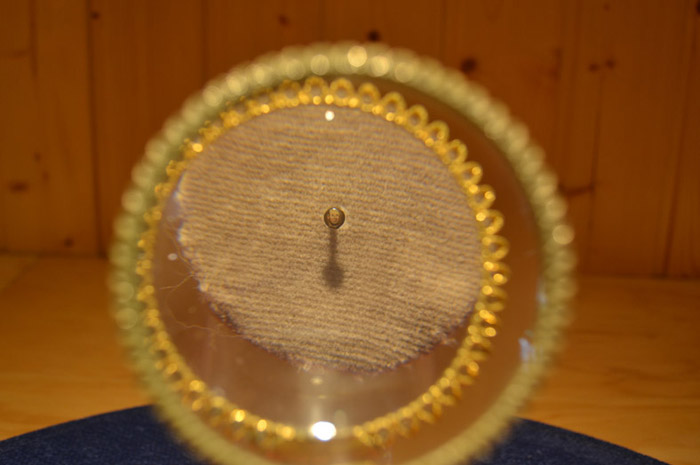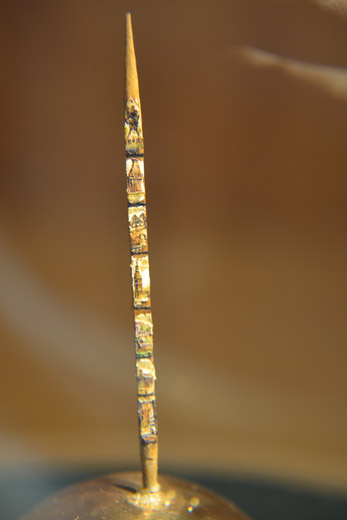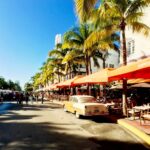Despite living on the Costa del Sol for many years, the writer had never visited the Carromato de Max, or miniatures museum, up in Mijas Pueblo. Things changed recently when totally by accident, she happened upon the colorful old wooden wagon, tucked away in the streets of this lovely, traditional white Andalusian town. Let’s just say, she is so glad she did!
As can be seen from the photos, this tiny museum is miniature in itself, but definitely worth a visit as the items on display are, quite simply, fascinating.

To first give a little background, the Carromato de Max miniatures museum opened back in May 1972 and is the brainchild of an unusual and bohemian character, Juan Elegido Millán, more commonly known as Professor Max. Born in Brihuega (Guadalajara), the professor had an interesting work history. He originally studied medicine and became a teacher, journalist and then finally a hypnotist and self-taught magician, and he then hit the road.
On his travels as a hypnotist, Professor Max became interested first in antiques, and then in the smaller side of life, as he said that being a traveller and adventurer with no home, he wanted to acquire items that he could carry with him in his suitcase. He collected a range of incredible items, around 30,000 to be exact. According to the museum they are worth around €600,000 in total. 360 of these curiosities are now on display in the unusual and unique museum.
Professor Max travelled throughout Europe, Latin America and Africa with a show dubbed, “A man and a suitcase form the world’s largest show.” However, Professor Max particularly enjoyed travelling in Africa and had many stories to tell about his adventures there.
One of the most valuable items in the museum was acquired on one such African visit where the Bauluba tribe initially wouldn’t allow him to visit. Eventually he persuaded the chief of the tribe to give him the honour of teaching him the practice of hypnotism. In return, Professor Max gained an extremely valuable and unique prize in the form of a shrunken head.
According to the professor, he later had the hair on the shrunken head analysed by the FBI who certified that it was the head of a Caucasian man, dating back around 100 years. You can see this unique, fascinating – and rather gruesome – item in the image below.

Despite the fact he enjoyed being a bohemian traveller, eventually Professor Max started thinking about his old age and he finally set up the miniature museum in Mijas Pueblo to earn a living. Unfortunately he wasn’t around too long after opening the museum as he passed away in 1975. The museum then passed on to his heirs who made an agreement with the Town Hall in Mijas to keep the fascinating venue open. It was in 1995 that the museum moved into the colourful wooden carriage where it is located today.

On arriving at the museum and reading the sign outside, it is hard to resist entering, as it gives a list of some of the most popular items, including a ballet dancer carved on a toothpick, Leonardo de Vinci’s “The Last Supper” painted on a grain of rice, dissected dressed fleas (yes, you heard right) and even a naval battle, painted on the head of a tiny pin.
Once inside and walking around the interior (pictured below) you will see a series of spheres containing the 360 treasures on display, together with the (very necessary) magnifiers to get a closer look at the items on display.

Besides the gruesome shrunken head, labeled “Head of a white man reduced by the Jivaro,” items on display have been developed using common, household materials, such as soap, rice, pins, matches, toothpicks, school chalk, a thumb-tack and even breadcrumbs.
Not to give too much away, some of the most fascinating miniatures include a portrait of former US President Abraham Lincoln, painted on a pinhead by the Ecuadorian artist, Willy Muñoz and “The Seven Wonders of the World,” painted on a toothpick.

You can see “The Last Supper by Leonardo da Vinci,” painted on a grain of rice by Andrade Guerra of Quito, Ecuador, who also wrote the Lord’s Prayer on the very edge of a card, readable with a good pair of eyes and the magnifying glass.
One thing to bear in mind, due to its small size there are no refreshments on offer in the museum and no toilet facilities available, so if you think nature might call, visit one of the many cafés or restaurants close by first, as once you are inside, fascination takes over and you will be there for a while!

The Carromato de Max is located in Avenida del Compás, right in the heart of the historic and touristic area of Mijas Pueblo, close to Plaza Virgen de la Peña, with its many cafes and restaurants and not far from the Town Hall – view Google Maps.
If feeling a little hungry after visiting the museum and if you can face the stairs, head up to the El Padrastro restaurant with its panoramic views, located right next to the museum, or enjoy a drink and some tasty tapas at Pampa Tablas y Tapas in the Plaza Virgen de la Peña, at Avenida Virgen de la Pena, 6, just a short walk away. If ice cream is the order of the day, head to Tartufo La Gelateria close by at Avenida Virgen de la Pena, 5. A little further down from the plaza at Avenida de Mejico, 19, the highly recommended Village Bistro gastropub offers a mix of Mediterranean, British and Spanish food to suit all tastes.
The museum is open every day of the week with varying hours depending on the time of year. From November up until Easter, it opens from 10am to 6pm, from Easter to June 30th and during September and October, the museum opens from 10am to 8pm and in the summer months of July and August, from 10am to 10pm.
Entry prices are reasonable at €3 for adults, €2 for pensioners and children from 6-14 can enter at €1.50 a head.
In conclusion, the Carromato de Max is a must-see venue on your Costa del Sol holiday, convenient to reach from all the coastal areas and a perfect, cool spot to visit and browse on a hot summer’s day.







